We may receive a commission when you use our affiliate links. However, this does not impact our recommendations.
This summer I have made two changes to my Roubo-style workbench that I built in 2005 that have made the bench even more effective and easy to use.
First up, a real-deal antique French holdfast, sent to me by a colleague in France. Clearly blacksmith made, this holdfast is sized somewhere between the monster holdfast that blacksmith Peter Ross built for my daughter’s workbench and the typical modern style.
It works like crazy, even in a full 4”-thick benchtop. The sucker sets itself so easily that I have to release it on occasion when I didn’t mean for it to cinch down.
Here are some statistics: The holdfast weighs in at 5 lbs. 6 oz. The shaft is 17” long. The neck has a 7” reach from the centerpoint of the shaft. The pad is 1/4” thick x 1-9/16” wide x 1-7/8” long.
Why does it work so well? My guess is that it’s the shaft. It measures about .985” in diameter all along its length. It just barely slides into a 1”-diameter hole. But slide it does. This close fit is what wedges the holdfast in place when struck with a mallet.
This fall I’ll take the holdfast to Ross in North Carolina and have him take a look. Perhaps he can be persuaded to make some for other woodworkers – it would certainly require less material and effort than the full-on beast he made for me as per Andre Roubo’s dimensions.
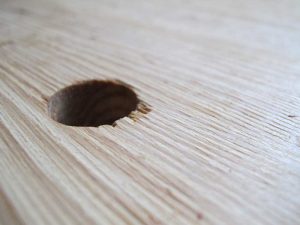
The other big change is that I toothed the entire surface of my benchtop. I got the idea years ago from Patrick Edwards, who has been toothing his bench for years and has evidence that it was common practice.
Several woodworkers I have talked to have told me that toothing the benchtop makes it grippier.
Intrigued, I tried it.
The result? It does help prevent your boards from sliding side-to-side or pivoting when planing them against a planing stop. It doesn’t feel any different to me when pushing the work forward against a stop.
But that’s a good thing. Most of the time I don’t want my boards pivoting when I plane them against a single-point stop. And the toothing seems like it helps that.
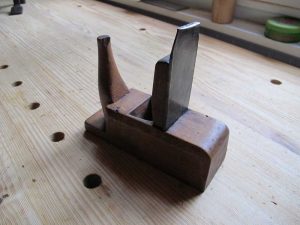
Sure, the toothed surface doesn’t look as nice as a finished tabletop or swanky bench. But I’ve never been in the “beautiful bench” crowd. Toothing the top of my 8’ bench took about 15 minutes with a toothing plane, which is typically used for roughing up a surface for traditional hammered veneer. After roughing up the benchtop I brushed it off and went to work – no finish.
As always, we shall see how these two traditional touches to my bench fare in the coming months. I’m optimistic.
— Christopher Schwarz
Here are some supplies and tools we find essential in our everyday work around the shop. We may receive a commission from sales referred by our links; however, we have carefully selected these products for their usefulness and quality.



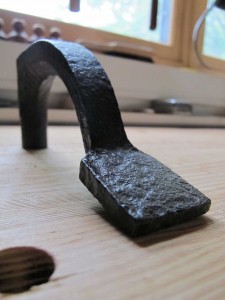
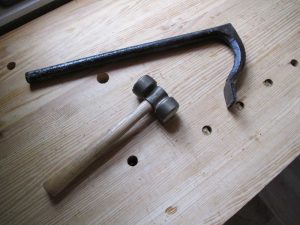
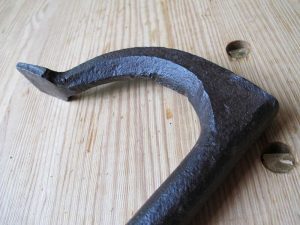







I am in the process of building my workbench and I want to get a couple of good holdfasts. Does anyone know where I can get a good one? I’m not sure of the quality of the one from rockler. They also only show one size.
Thanks in advance,
Fred
http://www.tampabaywoodworking.com
Chris,
I’m about to embark on building my first Roubo, exactly like the August 2010 issue. Do you foresee any issues with the mortise and tenons if I choose to use a laminated cherry top instead of the two slabs you’ve used?
Thanks
I was thinking about resurfacing my bench soon and leaving it unfinished. The underside would still have the existing finish on it though… Should I strip both sides to avoid catastrophic cupping?
Could you tell me how to space the holfast holes, both in line and from the edge?
many thanks
Pedro
Could you tell me how to spade the holfast holes, both in line and from the edge?
many thanks
Pedro
I’ve been meaning to make some hold fasts. Maybe this is just the insperation I need. I wonder if being made from actual wrought iron, as opposed to the mild steel we use today, makes any difference.
I wonder if those of us who haven’t gotten around to buying a toothing plane could use some really coarse sandpaper to achieve a similar result.
Chris nice to hear the report on the toothed surface. I have been thinking about this for a bit now. The benches I work on at the Steppingstone museum are very rough and beat up as they are each over 150 years old. While they are not toothed, they are really beat up. I have noticed a significant increase in stickiness to the surface and was considering ways to simulate this on my Roubo at home. Plus the couple of areas of switchback grain that I can never get tearout free will blend in with the toothed surface.
For whatever it’s worth, that holdfast sure does look like a holdfast! I’m sure it holds like one too! I love your description of it; it’s almost like an infomercial for holdfasts: The secret, the nearly 1″ thick shaft, it gives you holding power that other brands just can’t compete with!
Interesting (and covet-able) holdfast. I’ve been experimenting a lot with the ones that Junior Strasil made for me and they hold pretty dang well. But they don’t particularly like a bench that is thicker than 3″. By counter-boring the dog holes to make the 3/4″ portion 3″ thick, they work great. Kinda fun to see how far I can flex the arm.
How do you feel about the fancy LV Veritas hold-downs (05G14.01) are after having had them for a while now?
I seem to have a self-toothing bench as its surface is getting a bit rougher all on its own.
when I made my bench, I got a pre-made laminated maple top a fellow had made for an assembly bench from Craigslist for pennies on the dollar over what I’d pay for maple. It was nice because it gave me something I could slap on my sawhorses and get to work with right away. It was too wide, and a bit thin, so I ripped it in half, and laminated it face to face. (which worked well, except I now had 4 maple faces to true up) and added a bit of wood to each side to get back to a width I wanted and add a dog strip in the front.
Because the original fellow was a power-tool worker, the grain was every which way. So I did most of the work across the grain or diagonally. I ended up smoothing one face nicely , although it was a pain as I had to keep changing direction.
The face with the rough surface from working across the grain and tearout from going the wrong direction was much nicer to work on. It ended up being the show face.
Sometimes I still wish I had ripped the pieces back apart to deal with some of the poor glue joints, but staggering the glue lines when I laminated the two pieces from the original slab has made things sturdy enough, I just pretend the splits aren’t there.